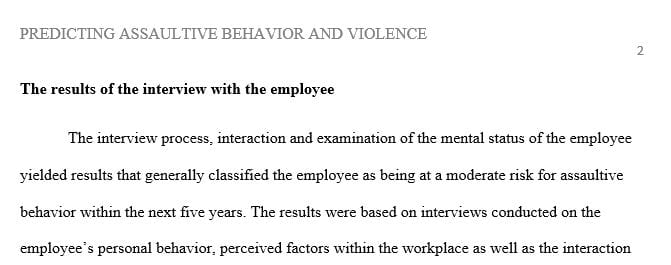A specific review of the employee’s predictors of violence factors
Assignment 2: RA 2: Written Report
You have completed your assessment of the employee and have the required information about the employee. You also have the information about three other predictors you reported in M4 Assignment 1. You have also administered a risk assessment instrument, and the employee has been classified to be at moderate risk for assaultive behavior in the next five years.
On the basis of the results of your investigation, in a mock report format based on the module readings and vignette data for the assignment tasks of the previous modules, create a 10- to 12-page report addressing the following:
The results of the interview with the employee (a description of your mock interaction with and the mental status examination of the employee)
A specific review of the employee’s predictors of violence factors
An analysis of the validity and reliability of risk assessment instruments for making predictions of violence appropriate for the employee’s assessment
The mock conclusions you arrived at about the employee’s potential for showing violence, while explaining reasons for such conclusions
Some cautionary statements about the tenuousness of your conclusions, given the low base rate of violence in the employee
In addition, in your report, identify at least one potential victim of the employee. Make a recommendation for action by the company to protect that victim. Prepare your findings and recommendations in such a way that the employee cannot effectively sue the company for slander. An axiom of law is that negative statements do not constitute slander if they can be supported. Your job is to write the report in such a way (with supportable conclusions) that the company can establish that its actions were prudent.
Here is M4_A1
Because deception is a social act, the Facial expression will not be the only clue. There is different language, verbal and written output that is essential in detecting a distinctive pattern. Taking a longer time to start the answering of question is a primary clue for possible deception. This happens when the liar has no time to plan. Moreover, most liars seem to be nervous and always complaining as well as talking much. In case the decision made does not favour their side, they appear nervous and start to complain about the decision made. Additionally, a state of deception can be detected in a situation where the subject appears to be less cooperative in a content that involves direct conversation (Ekman & Friesen, 2014). Most of the liars appear to withhold information. This might be attributed to the guilt from their action, or to cultivate sufficient time to plan and get their stories straight.
Adults with low intelligence
Different deception indicator will be less valid. Taking, for example, a situation that involves the respondent answering question. In case he/she have sufficient time, he will be able to adequately plan and give an answer that maintains a certain trend of truth. Moreover, he will not waste time when answering the questions. This case will be contrary to the situation when the respondent has been ambushed and asked to respond to the same questions. On account of the two scenarios, the validity of the indicator (Taking a longer time to start the answering of the question) will have varying levels of validity.
Liars will be nervous when defending an allegation. In most cases, a state of deception will be portrayed by the respondent state of nervousness. When supporting their claim, liars will keep on blinking eyes more frequently. In addition, a person who is lying will not have the confidence to maintain eye contact. In most cases, they shy off and give an incomplete statement. The indicator will be less valid in case the involved population have an elevated self-esteem.
In case the population is involved in a convocation, they will withhold information and fail to observe the aspect of turn taking. Because of the population low intelligent level, they will talk only when asked to and give information that lacks fundamentals.
References
Ekman, P., & Friesen, W. V. (2014). Detecting deception from the body or face. Journal of Personality and Social Psychology, 29(3), 288.
O’Sullivan, M. (2015). Emotional intelligence and deception detection: Why most people can’t “read” others, but a few can. Applications of nonverbal communication, 215-253.
m4_a2_jones_damita (1) m3_a2_jones_damita (1) m2_a2_jones_damita (1) m1_a3_jones_damita (1) m4_a2_jones_damita (3) new_question_1 (1)
Solution preview for the order on a specific review of the employee’s predictors of violence factors

3298 words